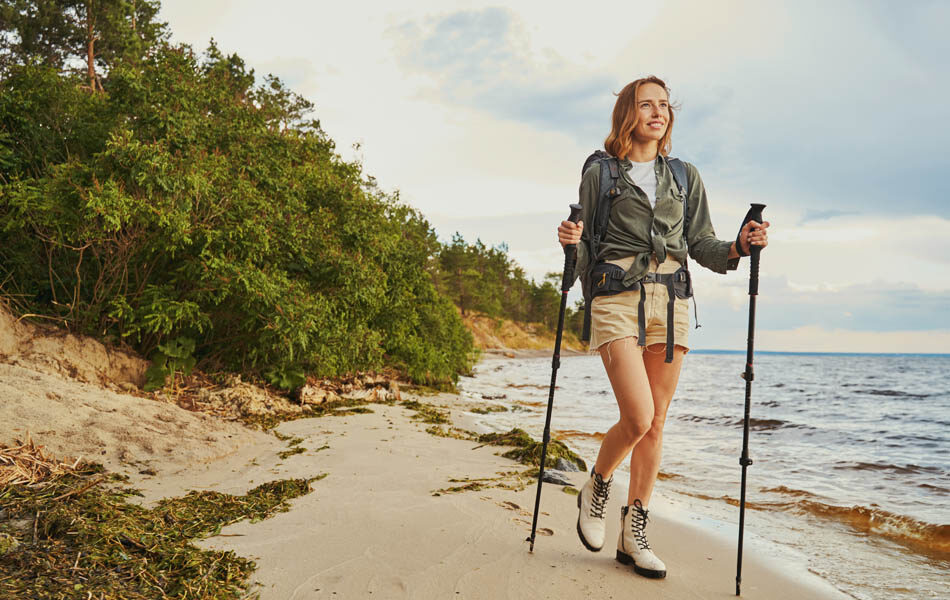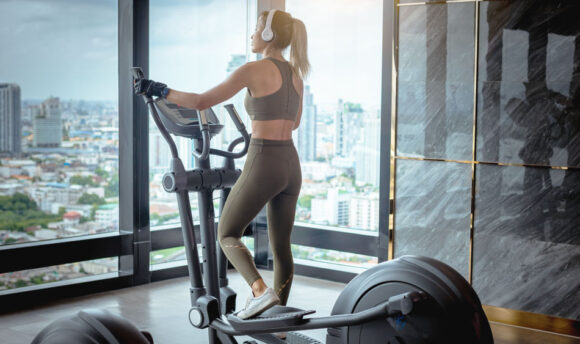Nordic Walking: Techniques, Benefits, Disadvantages
Nordic walking is a full-body workout that has been around for years, but what is it exactly? There are many ways beginners can try this low-impact walking style. We explain what Nordic walking is and give you the benefits and disadvantages of doing this exercise every day.

Going for a normal walk might seem boring to some people.
Even though daily walks are great for your health, there are certain things you can do to spice up this exercise. Nordic walking is the perfect example of a low-impact, full-body workout.
The Finnish-origin walking style focuses on targeting every muscle group. Instead of casually strolling through the park, you’ll be using special Nordic poles to guide your movement. There are many benefits of this unique exercise, but how do you learn the best Nordic walking techniques?
In this article, you’ll discover more about Nordic walking, including its benefits.
What Is Nordic Walking?
Nordic walking is a cardio-based exercise that requires you to use poles. The continuous pole movement activates your upper body muscles. Some experts believe that Nordic walking targets all muscle groups and helps you burn more calories during the walk.
Nordic walking began in Finland, where athletes competing in cross-country skiing used poles to venture outside. Ever since, cross-country skiers have continued the trend and encouraged others to use walking poles.
Regular walking or walking barefoot is still perfectly fine for exercise, but Nordic walking burns extra calories, strengthens your neck and shoulder muscles, and lowers blood pressure. You can target major muscle groups by finding the right arm swing when walking with the specially designed poles.
One thing to note is that Nordic walkers go through several training periods. This ensures they’re following the right movement and don’t injure themselves. They can learn how to use the wrist straps on Nordic poles, which prevents joint pain around the wrists and elbows.
Nordic Walking Technique for Beginners
Of course, starting Nordic walking might be confusing. There are many ways beginners can learn how to navigate special Nordic walking poles. Remember, take each small step at a time, as you don’t want to cause unnecessary injuries from doing this workout.
The first step is to adjust the straps on your walking poles. Just tie them around your wrists, but don’t do them too tight. You can then start to walk slowly forward on a flat path with your arms dangling next to your hips. Don’t hold onto the poles; let them trail behind you naturally.
Secondly, increase your casual walking speed and arm swinging action. The Nordic walking poles should start pushing into the ground. When they start sticking to the ground, grip the top of the poles gently and propel yourself forward, building up momentum using the sticks.
To avoid injuring your wrists, only grip the poles when each arm swings forward and the pole touches the ground. You’ll be able to push off from the poles when walking at a fast pace. Practice this movement for a few minutes until walking with poles becomes second nature.
5 Health Benefits of Nordic Walking
Once you master the simple Nordic walking technique, you can venture out into the world and gain some amazing health benefits. People usually find walking with poles exhausting, but that’s only because this Nordic workout gets your heart pumping to burn at least 500 calories.
Here are 5 health benefits of Nordic walking:
#1 Boosts heart health
There have been studies that show how Nordic walking strengthens your heart. This is because full-body workouts increase blood flow and lower the risk of blood pressure spikes. Your heart beats faster during exercise, which relaxes the arteries and reduces cardiovascular strain.
Another great thing about Nordic walking is that it slowly eliminates visceral fat. Most of this fat wraps around your abdominal organs, increasing the chances of heart disease. Someone with a high body fat percentage may get type 2 diabetes, hypertension, or even heart attacks.
#2 Promotes weight loss
Nordic walking is great for reducing fat around your face, upper belly, thighs, and arms. The constant movement means your body is always burning calories. Of course, the more calories you burn throughout the day, the more likely you’ll lose weight in just a few weeks.
People who walk normally still lose some fat, but the results might not give them a total body workout. Nordic walking poles are there to get your muscles moving continuously, which naturally takes up energy and requires hidden fat stores to maintain your exercise movement.
However, if you want to lose more weight, you need to follow a low-calorie diet while going for a regular Nordic walk. The ketogenic diet is a good place to start on your weight loss journey. Being in a calorie deficit should encourage the body to burn more calories during a walk.
#3 Strengthens your joints
You might enjoy Nordic walking due to the low-impact movement. The special trekking or hiking poles support your weight and stop any strain from damaging your joints. Ordinary walking has more of a chance of hurting joints in the knees, hips, and ankles, even when going slow.
Some Nordic walkers do this exercise to reduce arthritis pain. Nordic walking poles encourage you to use upper body strength and core muscles. This means you’ll put less pressure on joints, leading to better arthritis management that doesn’t flare up during full-body exercise.
Just make sure to consult with your local doctor before learning how Nordic walking works. You don’t want to cause more painful inflammation in your body. It might be worth doing joint-strengthening movements at home to ensure you have a good amount of muscle strength.
#4 Tones upper and lower body muscles
Nordic walking has the ability to burn fat instead of muscle. You’re constantly using your upper body to form a normal arm swing. Ordinary walking doesn’t even target muscles like the shoulders, upper chest, and back, so it’s worth implementing this exercise into your routine.
Obviously, we can’t forget about the muscles in our legs. Trekking poles that are designed for Nordic walking will help tone your quads, hamstrings, calves, glutes, and hip adductors. You’ll constantly be moving your whole body while propelling yourself forward with the sticks.
#5 Improves mental health
Yes, believe it or not, Nordic walking can improve your mental health. When your heart is pumping hard during exercise, hormones called endorphins fill the brain. These happy hormones automatically lift your mood and relieve symptoms of depression and anxiety.
Regular walking can have the same effect, but trying the Nordic style may be more enjoyable for everyday exercise. Getting out of the house comes with many positive mental changes. You could have better concentration, energy levels, fewer stress moments, and higher self-esteem.
Just remember that too much stress and anxiety raise blood pressure. Some cross-country skiers usually go outside just to feel better emotionally. If you feel down one morning, grab those specialized trekking poles and enjoy the fresh air on your exhilarating walk.
3 Disadvantages of Nordic Walking
Even though Nordic walking is really good for your health, it still comes with some disadvantages and potential risks. You should always learn the proper technique before trying this exercise or speak to your doctor to outweigh the long-term benefits and downsides.
Below you’ll find 3 disadvantages of Nordic walking:
#1 Possible risk of falling
One great thing about regular walking is that you don’t have a huge risk of falling. Nordic walking is slightly different, as you typically walk faster while using the poles. People who don’t pick up their feet enough or travel on bumpy surfaces could face some injuries.
However, this doesn’t mean you should be afraid of Nordic walking. All you need to do is focus on your lower and upper body movements. Start this exercise off slow, paying attention to your feet, and gradually increase your speed until you feel comfortable using the poles.
#2 Requires training
With any new form of exercise, you have to grow accustomed to the movement, distance, style, and pace. Nordic walking targets more muscle groups than ordinary walking, so it’s important that you engage them. Failing the movement could lead to knee pain or even balance issues.
Remember that athletes still need to train when participating in sports. They can’t use muscle strength if they don’t know how to perform the activity. Some experts suggest doing 150 minutes of moderate-intensity exercise a week to get fit and learn new, important skills.
If you need extra guidance when doing this exercise, the Walking.Diet plan offers personalized training and nutrition. You can take a simple quiz that details your goal body weight, dietary preferences, daily walking habits, current exercise routine, and overall health status.
Walking.Diet educates people about walking and encourages them to stay motivated. From healthy recipes to daily walking tracks, you’ll find something suitable for your goals. There’s no harm in learning more about your current interests and how they’ll benefit you in the long term.

- Offers walking training plan
- Provides warm-up and cool-down workouts before and after walking workout
- Includes keto desserts cookbook
- Offers the articles about food and nutrition, walking gear
#3 The poles can be expensive
Buying the right equipment is essential for this type of walk. However, most Nordic walking poles are expensive, meaning not everyone can afford them. The price typically ranges from $70 to $200, which is a lot for someone who wants to try the exercise at least once or twice.
Of course, you don’t have to pay this price, but it’s worth pointing out before you shop online for some. This expensive equipment only suggests that the poles are high-quality. Some brands only use rubber tips on the poles that grip the ground and stop you from falling during a walk.
FAQs
You should do Nordic walking 3 times a week for at least 45 minutes. This amount can get you into shape and improve your brain, heart, and joint health. If you don’t have that much time in the week, go for a quick 10–20-minute Nordic walk every morning to wake up your body.
Yes, consistent Nordic walking can help you lose stubborn weight gradually. The full-body workout targets all of your muscle groups and requires more energy. Going on these Nordic walks while using the poles can burn lots of calories, leading to better long-term fat loss.
Nordic walking is a full-body exercise that gets all of your muscles moving. You can use your arms to swing the poles and your legs to walk at a sustainable pace. Even though this is a low-impact workout, you can still lose weight and tone the glutes, quads, and calf muscles.
People use Nordic sticks because they have a good grip. They are designed to make Nordic walking more comfortable, especially for beginners. Normal walking poles might not be sturdy enough for everyday usage, so it’s worth buying yourself some specialized Nordic sticks.
Your heart rate can increase by 10–15% while doing Nordic walking. On average, men burn 19.9% more calories, whereas women burn 19.3% more calories during this exercise. This means that regular long-distance walks don’t boost your heart rate as much or burn a few extra calories.
A Word From a Coach
Nordic walking is like power walking but with two sticks. You use more muscles, including the ones in your upper body. There are many other benefits of this exercise, which focus on good posture, better workout times, and an increased fitness level for those starting their weight loss.
Before trying a Nordic walk, it might be worth doing some resistance training. This involves building muscular strength and endurance. You could use free weights to earn more of that strength, as this will stop you from feeling weak or off-balance when walking with the poles.
Just remember to consult with your doctor if you have any health problems. A medical professional can tell you whether Nordic walking improves or worsens your condition. Going straight into the workout could strain your joints and cause long-term damage.
Conclusion
So, is Nordic walking right for your goals?
This interesting workout has many benefits that support good health. You don’t have to be physically strong just to go for a walk while using some poles. All that matters is that you’re sweating, happy, comfortable, and feel motivated to get healthy during long walking sessions.
Don’t forget to take things slow when you first begin this particular workout.

















































 Select your language:
Select your language: 








